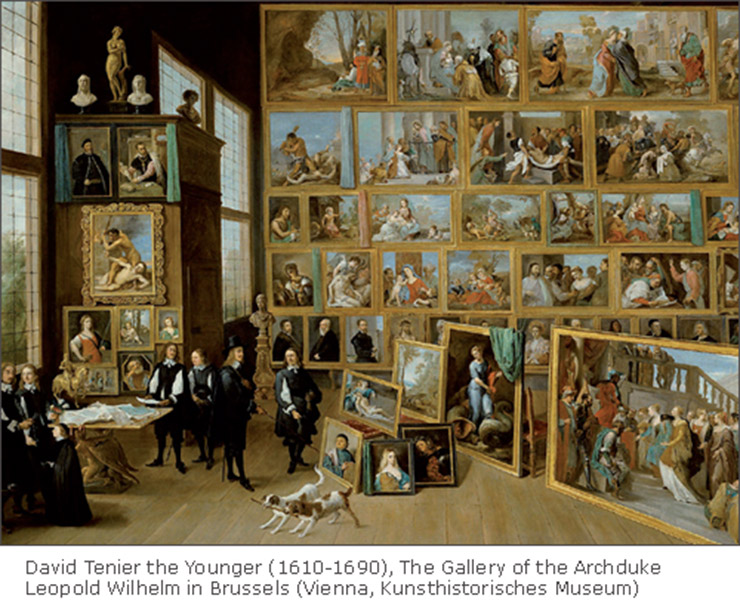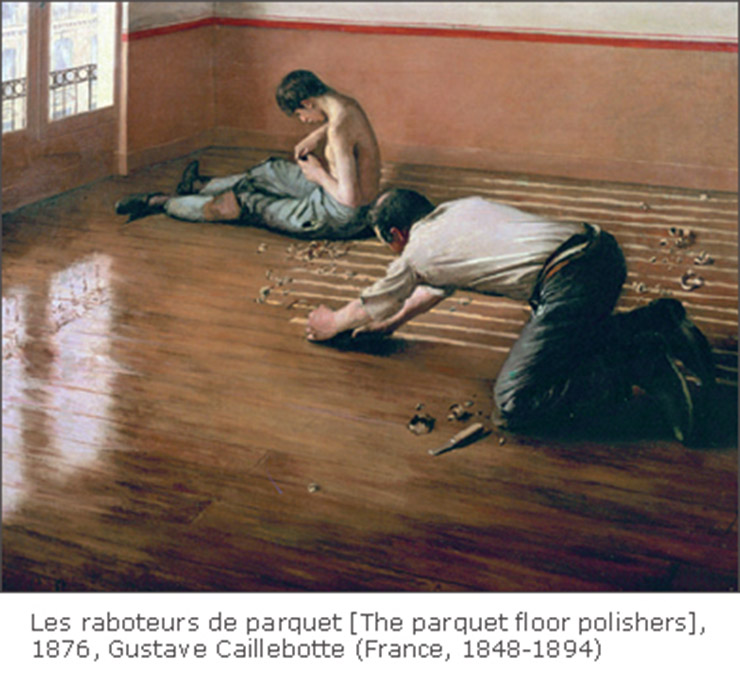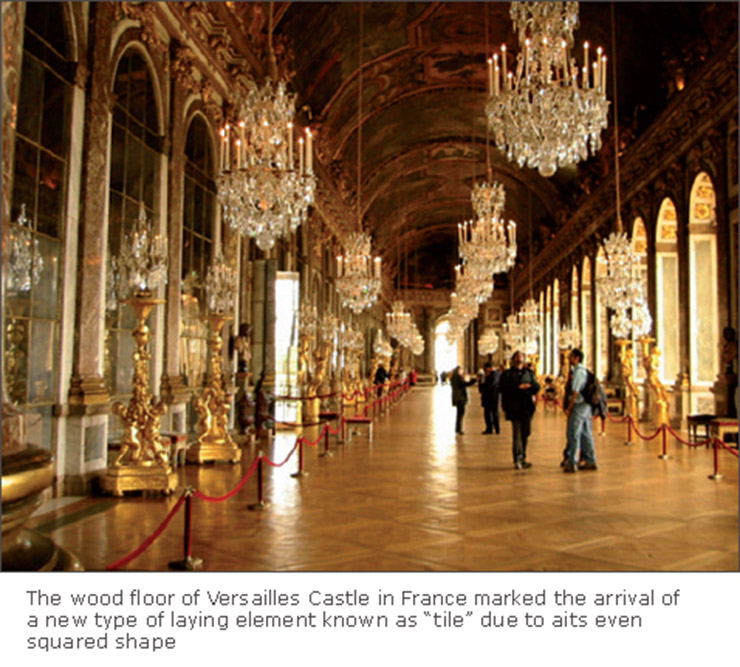PARQUET: yesterday, today, tomorrow
- Written by Domenico Adelizzi

When were wood parquet floors invented? What were the biggest steps in their development? Come with us on an interesting trip through the centuries...
Although wood floors are among the earliest features of human homes, it’s practically impossible to identify the oldest wood floors or the shapes of formats first used. Walking over a wood floor has always come so naturally to humans that no one has ever really taken the time to find out where or when we began doing so for the first time.
Whether they wore out, crumbled, burned away, or were shattered by armies, the most ancient applications of the technique surely disappeared a long, long time ago. The honor of our first real floor (after beaten earth, of course) almost certainly goes to stone, and to granite or sandstone in particular. By the time Man first began experimenting with terracotta or marble, he had most certainly already tried wood, yet no visible traces remain, unless you count stilt houses or palafitte.
The first significant demonstration of the use of wood for floors probably dates back to around the 10th Century BC, and consists of the numerous paintings of King Salomon seated on a throne placed on floors made of planks.
This pictorial evidence is the only credible proof of the use of boards for flooring, which were merely smoothened on the surface for the purpose.

From ancient Rome to the Middle Ages
The Ancient Romans were the first to bring design to the laying of floors, especially their brickwork floors, and invented the testacea spicata e opus pattern that we call herringbone today. The Romans also developed the various techniques for the sawing of the trunks required to make boards, in this way enabling the development of the floorboards, and consequently the first real wood floors. By the final decades of the First Millennium, the use of wood floors had spread throughout Northern Europe and the colder areas along the Atlantic Coast. Most were built with Oak, Pine, Spruce and Larch felled in forests nearby. The trunks were worked into formats that closely resemble the ones we use today: planks, blocks, and strips. By the end of the Middle Ages, people had acquired a taste for inserting different types and hues of wood planks into complex geometrical patterns. Well-preserved examples of the oldest indoor wood floors laid between the Gothic Period and the 15th Century can still be seen today in both Great Britain and Scandinavia.
From Medieval times to the 17th Century
This was when inlay was first developed with the use of both local wood and the first exotic varieties brought back to Europe by navigators sailing afar East and West. Wood floors became even more popular in the second half of the 17th Century when unknown craftsmen with refined artistic sensitivity and a special feeling for wood laid fanciful and complex patterns that were also inspired by the arabesques they had seen during their travels to distant lands. This work highlighted both wood’s decorative and aesthetic qualities and the craftsmanship of the men who laid it by choosing different types of planking and working it into strips, fillets, lath, inlay, decorative elements, and veneer, which when carefully fit and glued together using natural adhesives (based on rennet, egg, oxblood, and isinglass) produced elegant harmoniously and chromatically balanced floors. These techniques were the foundation for a model and working method that continues its development even today.

The Golden Age of parquet
In their glowing and abundantly-detailed representations of domestic life, Flemish painters often provided testimony of the use of wood floors. During the 1700s, the interior decoration of the most illustrious palaces and villas was essentially based - thanks to the achievement of a determined effect of balanced harmony - on the composition of the inlay in the floor. Attention to the floor’s formal and graphic value very often became the dominant element in the room’s décor and dictated the choice of every other element of furnishing. This was the Golden Age, the period of highest expression of the technique of inlay and wood decor. Important architects like Juvara took great interest in this versatile element of structure and design as it came to be used in Palazzo Madama in Turin, the Palazzina di Caccia in Stupinigi, Villa Reale in Monza, and in many other prestigious buildings in Italy. In France, the wood floors in the Castle of Versailles marked the onset of the use of a new laying element known as the “tile” with a regular, squared shape. The combined whole made by these large diagonal squares came to be known as “Versailles”. The builders of Versailles also gave us a complete series of floor laying pieces that included decorative frieze elements, divider strips, squares, fillets, inserts, and other elements used to frame the perimeter and highlight the room’s central area. This was when the term “parquet” was first coined as the way to refer to a “little forest”, due to the fact that the use of all this solid wood in the floors recalled the woods that surrounded Versailles and all the other majestic French and European mansions, villas and residences. The parquet (made with autochthonous and exotic varieties of wood) laid in the splendid buildings in and around Saint Petersburg is renowned in Russia; the work of the Architect Jacopo Quarenghi of Bergamo is famous throughout the world. In Italy, many architects designed and laid splendid wood floors, including Leopoldo Pollak, Simone Cantini, Alessandro Antonelli, Gaetano Kork and Giuseppe Piermarini.

Modern and Contemporary times
The architects of the modern movement and all contemporary architects have continued showing interest in wood flooring, such as Frank Lloyd Wright, with his villas in the United States, the Finnish Alvar Aalto, with his unquestionable mastery in matching different colored wood with the tones of surrounding masonry, Marcel Breuer, Richard Neutra, Charles Mackintosh, and the majority of Italy’s own brilliant architects. The most commonly-used types of laying element include regularly- shaped prismatic elements such as boards and strips, squared formats, such as the socalled tiles, trapezoidal elements, and “extra-long” planks (which in addition to making laying harder may sometimes even compromise the stability of the wood floor itself).

Oriental parquet
Wood has always played a particular role in the flooring of homes in Japan and the Far East from the earliest times. At first, the wood flooring that required resort to precious materials and the application of particular working techniques was reserved to the limited public building market. The use of many species of wood coming from outside Asia today and the bamboo that grows locally combined with the development of new woodworking techniques give this material a wider range of use (for use in theaters, schools, gyms, churches, industrial and residential construction) thanks to its costs more affordable than other materials.
Wooden components. From the origins to today
Although wood floors have always denoted a higher level of culture all over the world, wood could not be afforded by everyone until the previous century when our so-called traditional parquet composed of vertical and wide fingers, planks and strips with tongue and groove jointing first made its appearance. In the following decades, European species of wood were gradually complemented by others of African, South American, and South-east Asian origin. Regardless of the format or type of element to be laid, nowadays the technique most widely applied involves gluing. As regards laying patterns, end to end or ship deck patterns never go out of fashion. In the years to come, the coffering technique once used in ancient castles may even stage a comeback, thanks to the use of more modern elements, perhaps. In recent years, long-plank solid wood laying elements that have been judged impractical have lost some of their popularity. Now is the big moment for multilayer elements and alternative solutions (easy to lay but occasionally inadequate in quality), which are also aided by the growing trend in demand to lay the entire home’s floor parquet. This has led to the development of new, pre-treated, large-format elements with modified structures that improve chemical-mechanical characteristics and reduce moisture absorption to a minimum and the risk of swelling in consequence. There are heattreated elements with modified structures, others treated with acetylene, and yet others with mixed wood fibres + acrylic resin or propylene composition, not to mention the elements in two-layers of noble wood that enclose a central layer (usually softwood) running perpendicularly to the other two in order to ensure stability even with lengths longer than two meters. Laying often involves gluing, and the wear surface can be planed and sanded like any solid wood element, providing the additional advantage that damaged planks can be replaced without compromising the rest of the floor.




